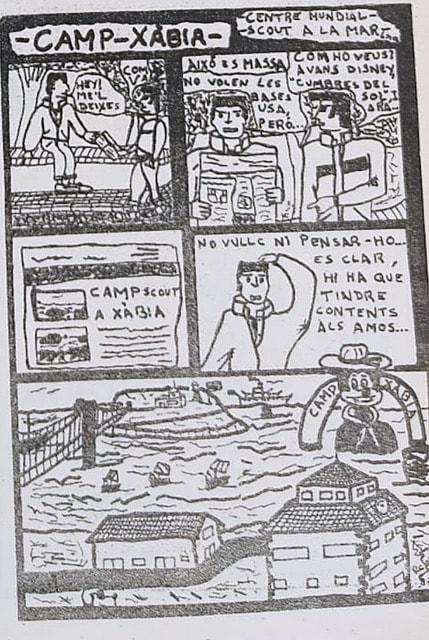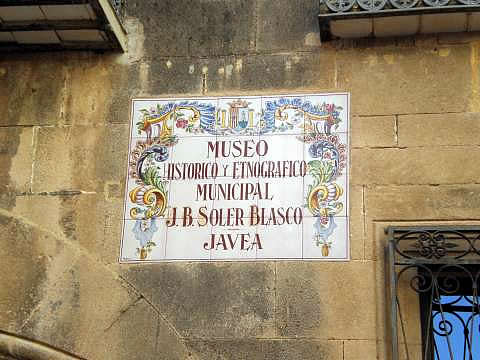|
In 1987-88 Xàbia averted a possible ecological disaster in one of the last few virgin coastal strips in its municipality, and with that, steered away from a future of mass tourism ? Xàbia today would not be the town we know, had the massive project of the International Boy Scouts been realised. This foresaw a World Center in the Portitxol area of Els Pallers, between Cap Prim and La Barraca. There they wanted to make a port for water sport activities and housing for at least 3000 scouts (there was even talk of increasing it to 10.000 !), with hotels for parents and staff accommodation in the vicinity.
The Central Government, the Generalitat Valenciana, the Conselleria de Obras Publicas y Urbanismo and even Javea´s ruling party at the time (PSOE), were pushing for the realisation of this project. Their arguments : it would bring not only Javea, but also Spain onto the international tourist map, promoting Xàbia (read Spain) especially to the American tourists, which in turn would bring profits to Xàbia & its businesses, and create jobs. However this did not appeal to the majority of the people of Xàbia, who were aware of the contradictions of the authorities : on the one hand, they had already been trying to limit urban growth and protect the coast (PGOU, General Town Plan), saying there was not enough water for the expansion of Xàbia, yet on the other hand they promote a huge project such as this World Center ! Six months earlier, the town of Peñiscola had rejected it, after studies had been done on the environmental effects of such a project on the coast. And now Xàbia was willing to accept it without any studies being done on the effects on marine life. Not only that, the Bronze Age archeological remains of Cap Prim and perhaps those of the island of Portitxol could be adversely affected by this new project. The PSOE (under mayor Enric Bas) found itself in opposition to the UPV Party (Unitat del Poble Valencià, led by Josep Sapena), various ecologists of the Marina Alta ( eg. Ecopacifistas and the Association for the Protection of Natural Patrimony), the AP (Alianza Popular, led by Eduard Monfort); and also the owner of the Portitxol island and that part of the mainland in question, Señor Guillermo Pons, who refused to sell the land for this project. Constructors and small businesses were also against the project. A petition signed by 2.600 Xàbeenses was handed in to the Ayuntamiento. During the final plenary sitting in January 1988, the decision was to reject the project, to the great relief of the population of Xàbia ! How admirable it is that the small town of Xàbia stood up to the pressure coming from the top to protect its beautiful natural environment ! Today Cap Prim and La Barraca are popular areas for walkers and nature lovers. Thank you, people of Javea !
0 Comments
|
ACTIVITIES
Categories |
- Home
- Blogs
-
Projectes
- Premio de Investigación - Formularios de Inscripción
-
Traducciones Translations
>
-
DISPLAY PANELS - GROUND FLOOR
>
- THE STONE AGES - PALAEOLITHIC, EPIPALAEOLITHIC AND NEOLITHIC
- CAVE PAINTINGS (ARTE RUPESTRE)
- CHALCOLITHIC (Copper) & BRONZE AGES
- THE IBERIAN CULTURE (THE IRON AGE)
- THE IBERIAN TREASURE OF XÀBIA
- THE ROMAN SETTLEMENTS OF XÀBIA
- THE ROMAN SITE AT PUNTA DE L'ARENAL
- THE MUNTANYAR NECROPOLIS
- ARCHITECTURAL DECORATIONS OF THE PUNTA DE L'ARENAL
- THE ATZÚBIA SITE
- THE MINYANA SMITHY
- Translations archive
- Quaderns: Versión castellana >
- Quaderns: English versions >
-
DISPLAY PANELS - GROUND FLOOR
>
- Catálogo de castillos regionales >
- Exposició - Castells Andalusins >
- Exposición - Castillos Andalusíes >
- Exhibition - Islamic castles >
- Sylvia A. Schofield - Libros donados
- Mejorar la entrada/improve the entrance >
-
Historia y enlaces
-
Historía de Xàbia
>
- Els papers de l'arxiu, Xàbia / los papeles del archivo
- La Cova del Barranc del Migdia
- El Vell Cementeri de Xàbia
- El Torpedinament del Vapor Germanine
- El Saladar i les Salines
- La Telegrafía y la Casa de Cable
- Pescadores de Xàbia
- La Caseta de Biot
- Castell de la Granadella
- La Guerra Civil / the Spanish civil war >
- History of Xàbia (English articles) >
- Charlas y excursiones / talks and excursions >
- Investigacions del museu - Museum investigations
- Enllaços
- Enlaces
- Links
-
Historía de Xàbia
>
- Social media
- Visitas virtuales
- Tenda Tienda Shop




 RSS Feed
RSS Feed
